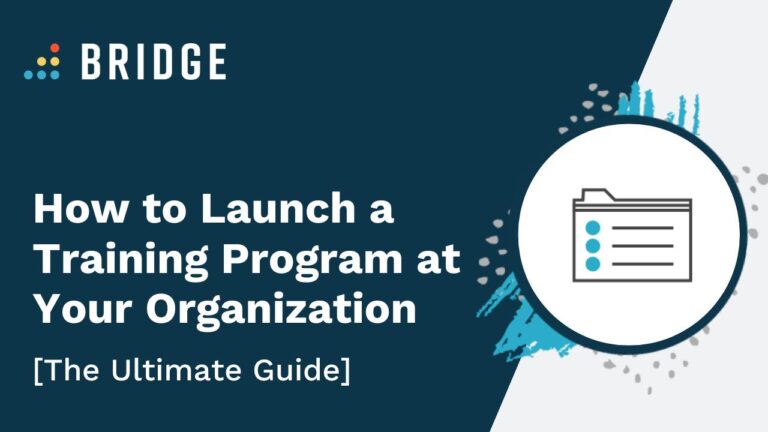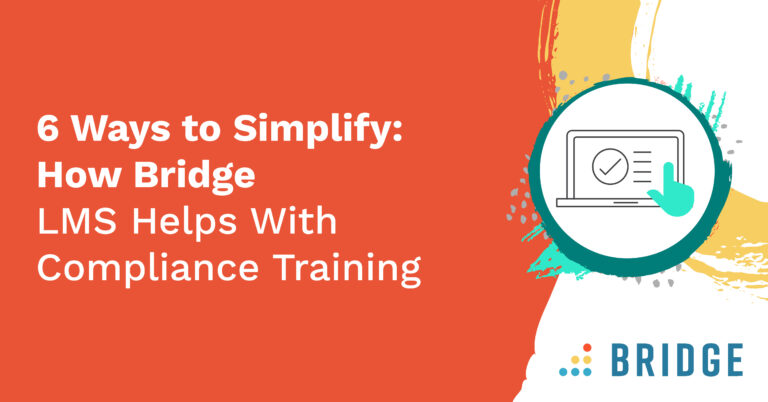As organizations strive to close skills gaps and give their people the tools they need to be at their best, the need for training is clear. Your employees want more opportunities to learn too. LinkedIn’s 2022 Workplace Learning Report shows that employees’ top three motivations to learn are all connected to their careers—they want training that keeps them up to date in their field, is personalized to their needs, and helps them achieve their career goals.
To make sure that employees get the most out of your company’s learning and development efforts, that you’re equipped to meet all of their individual needs, and that learning fits easily and seamlessly into their busy schedules, you need training programs that cater to these needs.
What Is Employee Training and Development?
Employee training and development describes the activities employees undertake to improve their knowledge, skills, and job performance. Ongoing training helps employees become more productive and do their jobs more efficiently. Employee training and development can make a clear difference. A Gallup report surveyed more than 15,000 US workers to gauge their interest in workplace training and explore the benefits. Report findings show that when employees are provided with upskilling opportunities, 71% have greater job satisfaction, 75% are given more opportunities for career advancement, and 49% consider skills training an important motivator for staying at their current job.
Employee training should offer your people opportunities to boost their knowledge and skills within their current roles, while development should focus on employee growth and future performance as they move into different roles.
RELATED READING | ‘Delivering Results: The Importance of Tracking Employee Learning’
Types of Employee Training
There’s no one-size-fits-all when it comes to employee training. Your organization should have learning and development in place for every employee based on both their needs and your company’s.
Here are some of the types of training you need to consider when creating a training program:
1) Onboarding Training
The first taste of training most of your new hires will have is on day one, so onboarding matters. According to Gallup, employees with a positive onboarding experience are almost three times more likely to feel satisfied with their workplace and stay in their roles. To get your newest employees up and running quickly, introduce them to the relevant job skills, team members, and software they’ll need to be familiar with in their day-to-day. Their training should also include an introduction to your company, its policies, and any compliance training they need to complete before they can do their job.
2) Compliance Training
Your new hires might not be the only people who need compliance training, as some organizations or roles will require employees to complete compliance training periodically or maintain certifications. It might be overwhelming to keep up with regulations, but an LMS can help to make sure your information is up to date and the right training goes to the right people when they need it.
BONUS! | Keep reading for access to our FREE Employee Onboarding Template
3) Leadership Training
Successful leaders are able to engage and inspire their employees, communicate their organization’s mission, and drive outcomes to deliver results. Data reveals that organizations are looking to managers to drive resilience and adaptability. In 2022, 49% are making management and leadership training their core focus and 29% are increasing their training and support for managers. Training encourages managers and leaders to find new ways of developing people, lead change and handle conflict effectively. With the right training, your leaders can connect with employees in more meaningful ways.
4) Soft Skills Development
Soft skills are becoming more important, but according to McKinsey, HR professionals are finding it difficult to recruit candidates with skills like critical thinking, creativity, dealing with ambiguity, and communication. Developing soft skills requires interactive learning that allows your employees to collaborate and provides opportunities for real-world practice and feedback.
5) Product-Specific Training
This is a must if your organization sells products or services and every employee that needs to be familiar with the product should be trained. Existing employees should be trained on every new product as it launches or as a refresher, while new hires will usually be introduced during onboarding training.
6) Role-Specific Skills Development
This is job-specific and will help each employee to better perform in their role and advance in their careers. They should identify the skills they want to improve and work towards these goals with targeted courses and on-the-job training.
7) Diversity and Inclusion Training
Creating a healthy working environment that promotes diversity and supports people from different backgrounds starts with awareness. DE&I training teaches employees how to report and recognize workplace harassment, how to embrace differences, and challenge personal biases.
WANT TO KNOW MORE ABOUT SOFT SKILLS? CHECK OUT OUR BLOG POST | ‘Tackling the Skills Gap: Could Soft Skills Be the Answer?’
What Elements Should You Include in a Successful Training Program?
Your employees’ needs are all unique, and they’ll need different types of training throughout their lifetime with you. Training programs are designed to address these needs and give employees the skills and knowledge they need to be the best they can be.
There isn’t a single simple answer to building the perfect employee training program, but here are a number of different elements to include for success:
1) Clear Objectives and Goals
Without clearly-defined objectives and goals, how do you know whether your training was effective? Every learner should have clear objectives and goals based on their needs, such as course completion rates, onboarding time, or an increase in learner engagement.
2) Specific Training Paths
Each employee has their own unique training needs, so this should be reflected in your program. Uncovering what everyone in your company wants to accomplish and the skills they need to get there means you can create individual learning paths with personalized training to give them the tools they need to achieve their goals.
3) Skills Practice
Learners should have the chance to practice new skills through practical assessments and on-the-job training. This will allow them to improve their performance and show how well they’ve retained knowledge.
4) Different Learning Formats
Not everyone learns in the same way. A successful training program should cater to different learning styles and offer formats that keep training fun. Formats like videos, quizzes, and games can keep learning fresh, and for remote and hybrid employees, peer-to-peer learning can help to foster a sense of community. A mobile app makes it easy for employees to access learning on the go, fit it into their schedule, and makes training convenient for field workers.
5) Easily Accessible Learning Materials
If it’s not easy for employees to access or complete training, it’s unlikely to be effective. Your materials should be easily accessible in a central location, such as an LMS, allowing them to complete training at their own pace.
6) Post-Training Assessments
Your training should be valuable to the person and situation. Asking learners a series of questions after each course can give you insight into what they thought about the material, whether they’re using the skills they developed, and how effective it was.
YOU MIGHT ALSO LIKE | ‘Planning for Success: The Importance of Employee Training and Development Plans’
Common Challenges of Developing Employees (And How to Overcome Them!)
Delivering employee training is crucial, but that doesn’t mean it isn’t without its challenges. Luckily, these challenges are easily overcome! Here are some of the most common workplace learning barriers and how to solve them:
1) Employees Don’t Have Time to Learn
Finding time for learning can be challenging for some, as research shows that 60% of employees find their volume of work a source of stress. If employees feel they can’t fit learning into their hectic workday, deliver useful training in bite-sized chunks so they don’t feel overwhelmed. Microlearning can make training more enjoyable for learners by breaking content down into small, manageable chunks. You can tailor modules to your target audience and deliver short bursts of learning using videos, making platforms like Bridge Learning Management System ideal for hosting microlearning modules.
2) Learning Isn’t Seen as a Priority
Research finds that 80% of employees see a company’s training and development program as an important factor when accepting a new role. But if L&D isn’t seen as a company priority, it’s likely they won’t get the most out of it. Learning should be seen as an important part of your company’s culture, right from day one.
Creating a learning culture means developing an environment that supports ongoing training opportunities for all your employees. It’s also about making learning an organizational value communicated by leaders, and encouraging knowledge sharing.
3) Employees Aren’t Engaged With the Training
If courses aren’t relevant, your people will quickly lose interest. In other words, you need to deliver personalized and relevant content according to their career goals. For mandatory training, mix it up with bite-sized courses and offer different formats to keep things interesting. Get feedback from course completion and use this to adapt your training, as this can help to make your learners more engaged.
4) A Lack of Meaningful Analytics
How can you make meaningful change without measurable results? To check how effective training is, you need a way to track and analyze learning data. Whether you want to increase course completion rates, bridge skills gaps to upskill your workforce, or cut down onboarding time, an LMS with reporting capabilities can track progress over time to monitor improvements.
FOSTER A CULTURE OF LEARNING IN YOUR ORGANIZATION | ‘Learning to Adapt: How to Put Learning and Development at the Heart of Your Company’s Culture’
Where to Start With Developing a Training Program
There are a number of considerations when it comes to developing a training program. The training and how you’re going to implement it will depend on individual learner needs, the resources you have available, and what you want to accomplish.
Think about the following questions:
1) What Are Your Employees’ Needs?
Developing a training program begins with asking the question “what do we need?” Deciding what issues you need to address, whether it be a skills gap, lack of product understanding, or ongoing compliance training will determine what kind of training programs you need to implement.
2) What Are Your Goals?
Setting goals is an important part of building a training program as it allows you to track and measure the effectiveness of learning. Where possible, align with organizational goals so everyone shares and supports the same mission.
3) Are Your Employee Training Plans Personalized?
An employee training plan is a framework for making sure every employee gets the right training at the right time. Plans should outline the training your employees need to undertake and in what order. To make sure everyone gets the most out of their training and development, plans should be personalized and job-specific.
4) Will You Design Your Own Training Materials?
Meeting the training needs of your people means providing them with content in a format they’re most comfortable with. By offering diverse content, your employees can learn in the way they want. Once you know what you want from your training programs, the next decision is whether you’ll be building that content in-house, buying an off-the-shelf product, or outsourcing its creation. Your needs may be so general that the training programs already exist, or so industry-specific that you need to start at square one. If you develop your own material, a content authoring tool makes it easy to build, adapt, and tweak courses.
5) How Will You Deliver Workplace Learning?
Delivering targeted and personalized training to your organization doesn’t have to be complicated. An LMS makes it easy to control all aspects of the learning journey and allows you to store, manage, and distribute content. Learning can be delivered in easily digested, bite-sized chunks and scheduled without disruption to the workflow.
6) How Will You Measure Success?
Analytics will tell you how many people completed the training and how long it took them, but your true success will lie in the knowledge and skills they learn and how they apply that knowledge to their everyday work. Your measures of this success will depend on the skills learned but, for many new skills, you can measure project completion times and productivity to see how they’re impacting your business.
You don’t necessarily have to measure success with metrics though. Success can take the form of a skills gap that no longer exists or a more innovative workforce.
How to Get Employees On Board With Training (And Not Overload Them!)
With so much information to take in, be mindful that some of your people could be overwhelmed. To avoid overloading them with learning tasks, here are some simple steps you can take:
1) Promote Peer-to-Peer Learning
Peer-to-peer learning means training is a collaborative effort as employees share their knowledge and learn from each other. Create content champions throughout your organization at a peer level so the weight is distributed vertically, not horizontally. This will give your people a greater sense of ownership over their learning and means that they’re not relying on the people at the top with limited time. It’s also a good opportunity for those with leadership and management performance goals to practice!
2) Utilize Video and Mobile Learning
If your employees are faced with the same format, it’s likely they’ll become bored and switch off. Make learning fun! Mix up your learning and offer different formats like videos, pop quizzes, and interactive training to keep learners engaged. A mobile learning app means that your people can learn away from the office when it suits them too.
3) Create Custom Learning Journeys
Breaking down learning into manageable chunks means no learner will become overwhelmed with their workload. With a measured and paced experience, their tasks will feel far more manageable, and this makes for a more engaging experience.
DELIVER LEARNING AND DEVELOPMENT TO THE RIGHT PEOPLE AT THE RIGHT TIME | ‘Go the Distance With Bridge Journeys’
How to Enable Self-Directed Learning in the Workplace
Successful training programs should be built around your people and the ways they want to learn. A LinkedIn Learning survey polled 2,000 Gen Z workers to understand their learning preferences and found that 43% favor an independent and self-directed learning approach. However, only 20% of L&D pros plan to deliver this level of flexibility.
Self-directed learning means giving your people the power to decide what they want to learn and when they want to learn it based on their own needs, the skills they want to master, and their career visions. It’s an important step in creating training programs because it gives them the opportunity to shape their own plan based on what they find valuable and meaningful.
Here are some ways to enable and encourage self-directed learning:
1) Provide Time In the Work Day for Employees to Learn
Self-directed learning places the responsibility on the employee, so you should create a supportive environment that makes time for training. In their hectic daily schedules, it’s easy to let learning fall by the wayside or be forgotten in favor of their other responsibilities. Encourage your employees to block some time out in their calendars each week for learning and make this a talking point with managers during one-on-ones. It doesn’t have to be substantial chunks of time—even 15-30 minutes of uninterrupted learning is a great start!
2) Connect Learning and Performance Goals
Your employees should understand the value of learning and development. Tying their learning goals to performance goals helps to enforce the value that your organization places on their learning.
3) Schedule Checkpoints for Feedback
Managers should show their support for employee training and development by creating a positive environment, offering encouragement, and giving relevant feedback. They should also make time to schedule regular check-ins with their employees to reflect on progress and learnings after each program.
4) Create Opportunities for Employees to Connect
Whether this is through your LMS, creating specific channels in your company’s messaging platform, or setting aside time each month for employees to present lunch-and-learns on their new knowledge, a platform to connect and share resources can inspire and motivate employees with their own learning journey.
HANDPICKED FOR YOU | ‘5 Ways to Combat Employee Loneliness and Support the Remote Workforce’
Find a Tool to Make Learning Easy
Bridge’s LMS makes creating and delivering high-quality training programs easy. With Bridge, you have the power to give your employees the tools they need when they need them—schedule learning into manageable chunks, control when learning happens, and schedule check-ins at key points throughout their training program to stay connected.
Bridge’s learning solution is flexible and can be personalized to meet the needs of every single member of your organization.




